Abstract
Antigen-specific cytotoxic T cells (CTL) are generally elicited in vitro by incubation of effector cells with an appropriate major histocompatibility complex-matched antigen-presenting cell (APC). In the case of CTL derived from inbred rodents, spleen cells from an animal of the same strain serve as a ready source of autologous major histocompatibility complex-identical APC. In outbred human populations, however, a convenient source of human leukocyte antigen-matched APC is ordinarily difficult to obtain, and for that reason human antigen-specific CTL may be difficult to propagate. We describe a method whereby Epstein-Barr virus-transformed human B cells (B-LCL) serve as a convenient source of efficient APC for the propagation of human antigen-specific CTL. B-LCL are produced by using B cells from the donor under study and are thus human leukocyte antigen identical to the donor. Using this method, we have propagated human CD4+ Toxoplasma gondii-specific CTL for up to 9 months in vitro, during which time the cells retained their functional capability.
Full text
PDF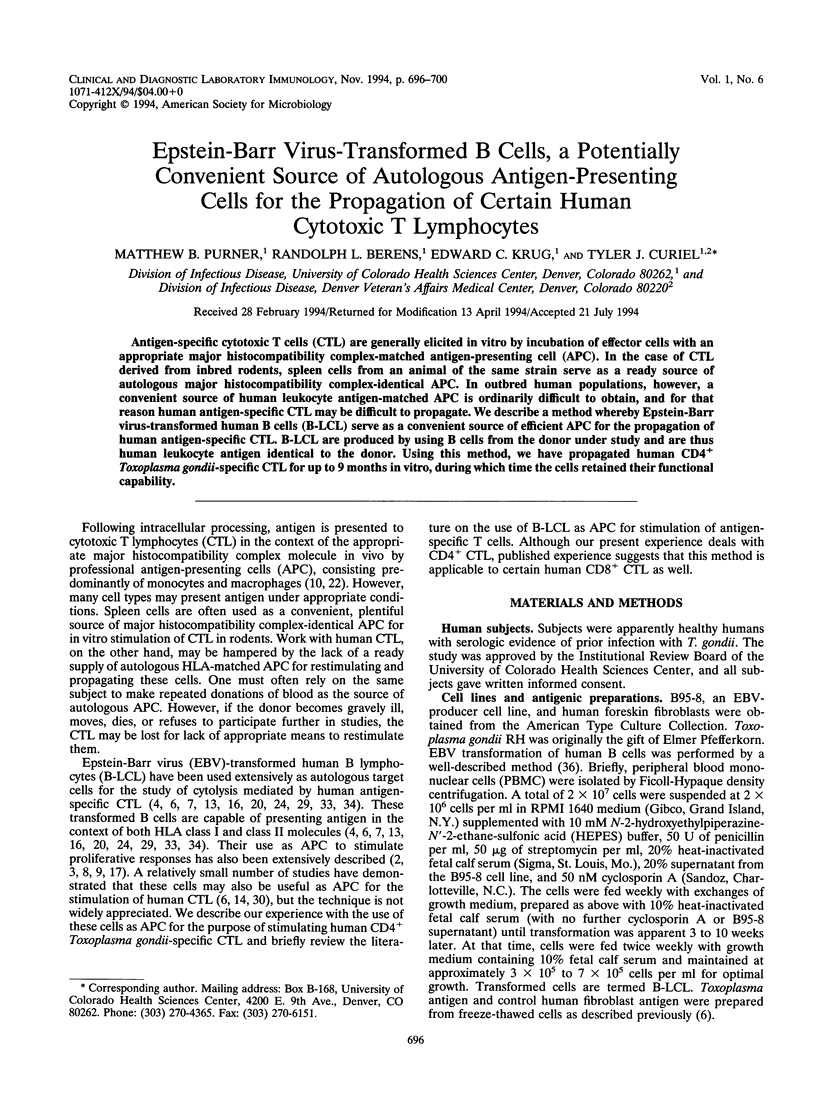
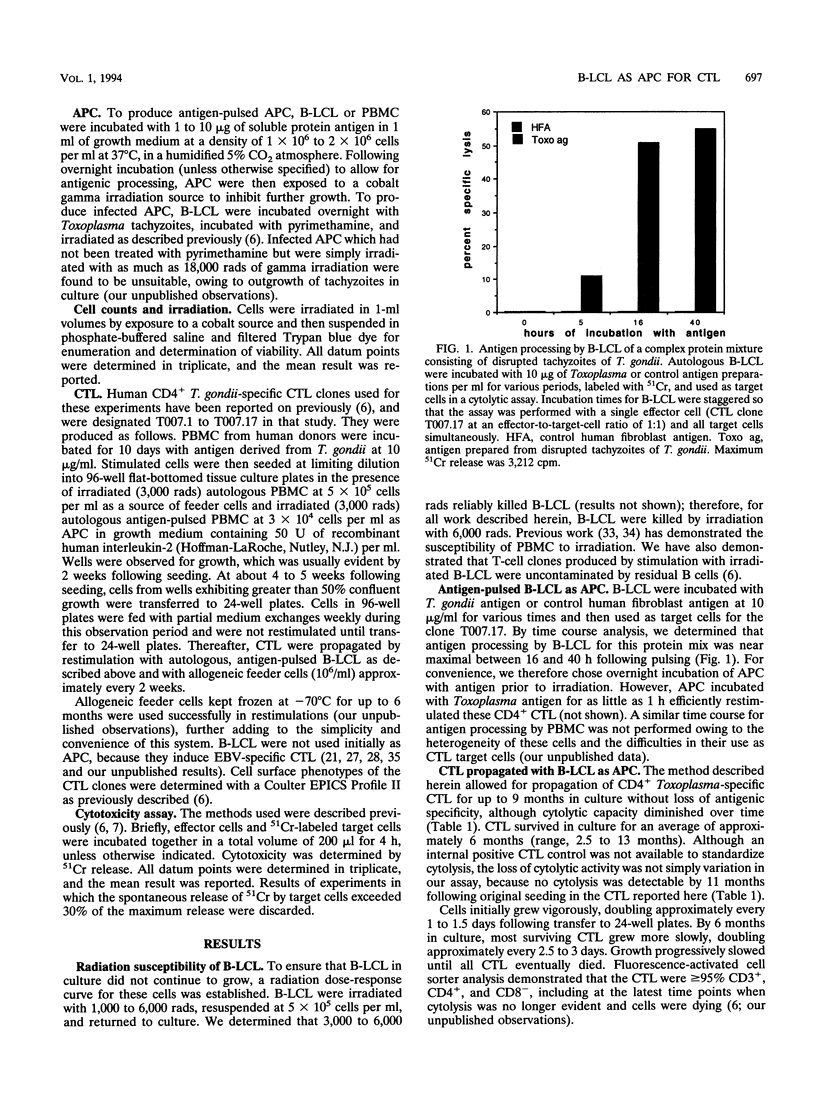
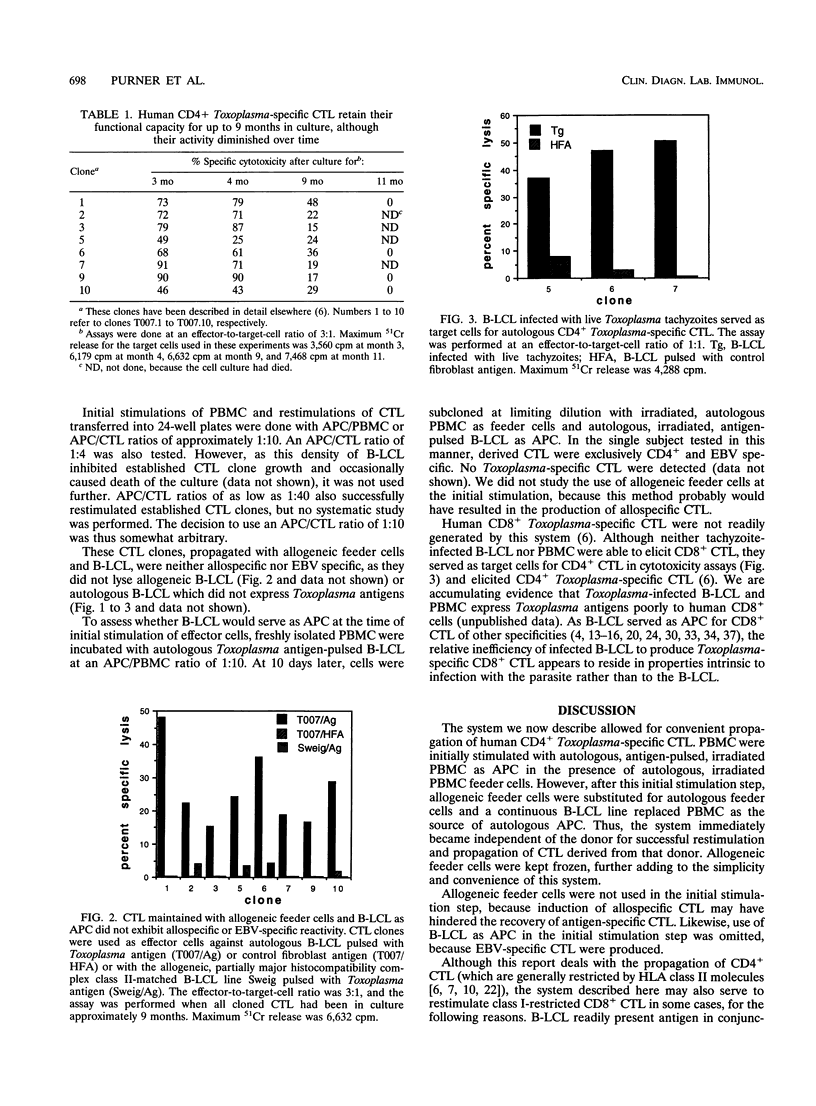
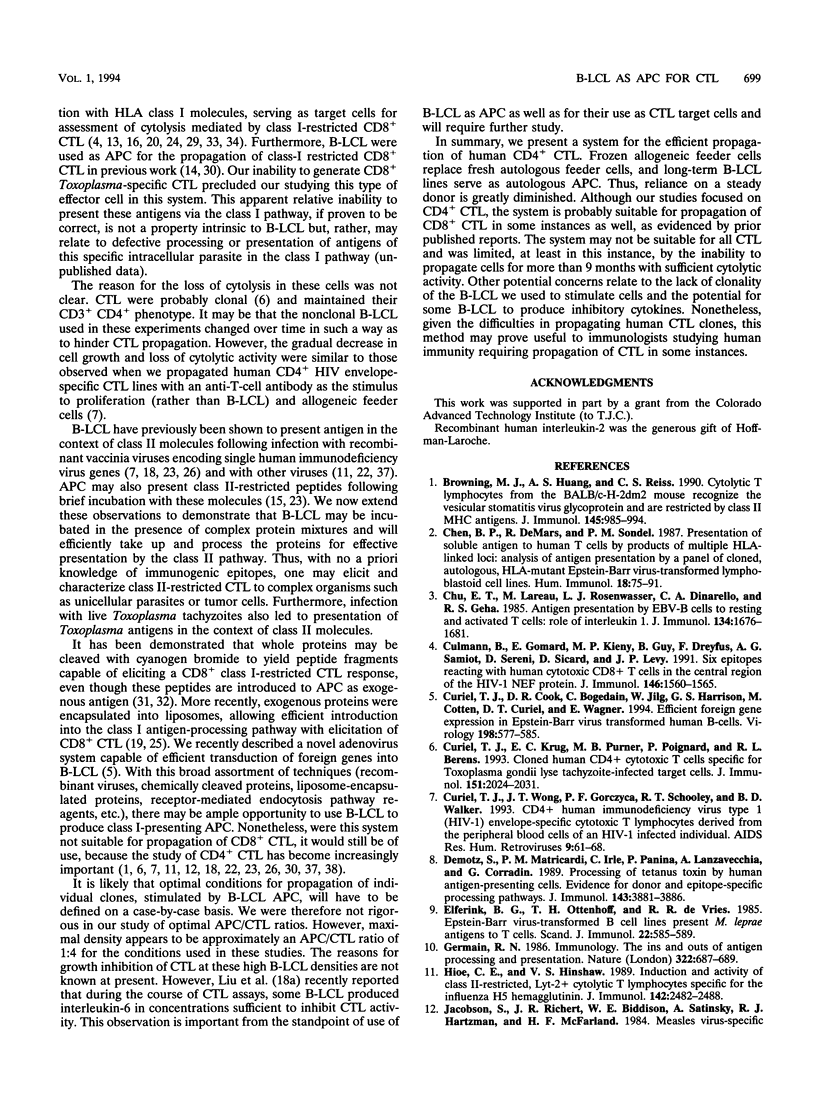
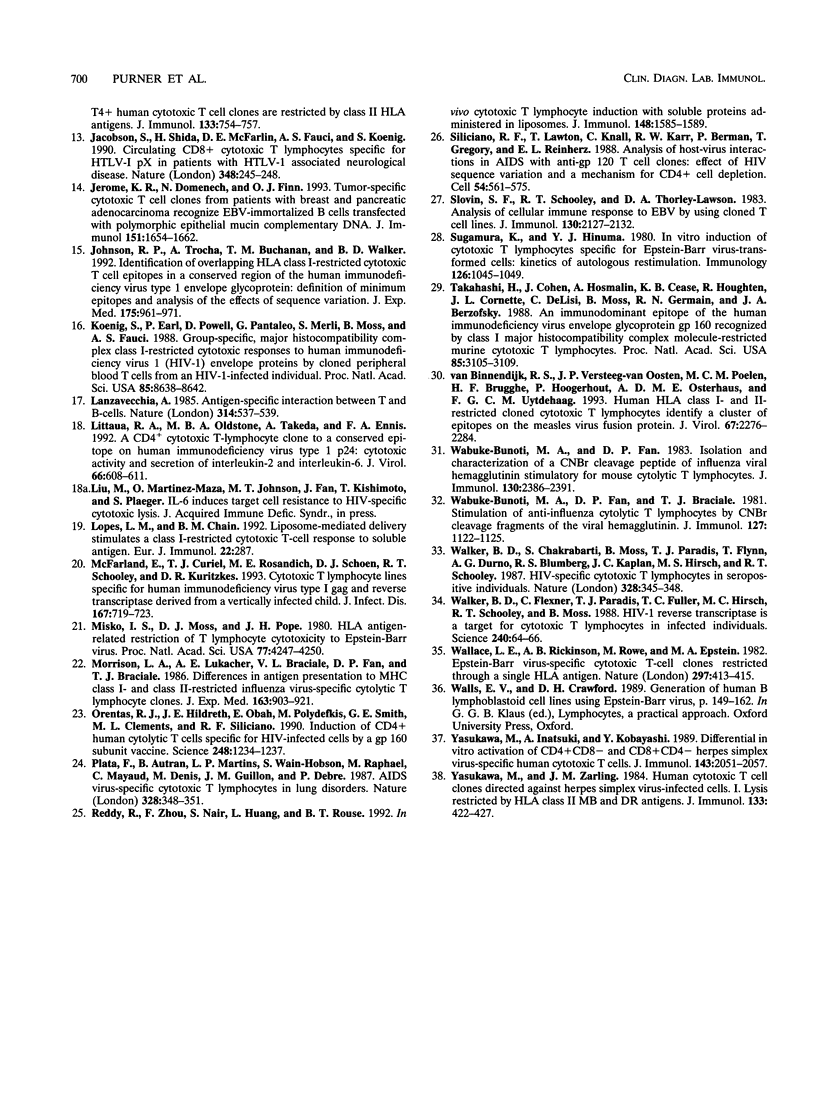
Selected References
These references are in PubMed. This may not be the complete list of references from this article.
- Browning M. J., Huang A. S., Reiss C. S. Cytolytic T lymphocytes from the BALB/c-H-2dm2 mouse recognize the vesicular stomatitis virus glycoprotein and are restricted by class II MHC antigens. J Immunol. 1990 Aug 1;145(3):985–994. [PubMed] [Google Scholar]
- Chen B. P., DeMars R., Sondel P. M. Presentation of soluble antigen to human T cells by products of multiple HLA-linked loci: analysis of antigen presentation by a panel of cloned, autologous, HLA-mutant Epstein-Barr virus-transformed lymphoblastoid cell lines. Hum Immunol. 1987 Jan;18(1):75–91. doi: 10.1016/0198-8859(87)90114-5. [DOI] [PubMed] [Google Scholar]
- Chu E. T., Lareau M., Rosenwasser L. J., Dinarello C. A., Geha R. S. Antigen presentation by EBV-B cells to resting and activated T cells: role of interleukin 1. J Immunol. 1985 Mar;134(3):1676–1681. [PubMed] [Google Scholar]
- Culmann B., Gomard E., Kiény M. P., Guy B., Dreyfus F., Saimot A. G., Sereni D., Sicard D., Lévy J. P. Six epitopes reacting with human cytotoxic CD8+ T cells in the central region of the HIV-1 NEF protein. J Immunol. 1991 Mar 1;146(5):1560–1565. [PubMed] [Google Scholar]
- Curiel T. J., Cook D. R., Bogedain C., Jilg W., Harrison G. S., Cotten M., Curiel D. T., Wagner E. Efficient foreign gene expression in Epstein-Barr virus-transformed human B-cells. Virology. 1994 Feb;198(2):577–585. doi: 10.1006/viro.1994.1069. [DOI] [PubMed] [Google Scholar]
- Curiel T. J., Krug E. C., Purner M. B., Poignard P., Berens R. L. Cloned human CD4+ cytotoxic T lymphocytes specific for Toxoplasma gondii lyse tachyzoite-infected target cells. J Immunol. 1993 Aug 15;151(4):2024–2031. [PubMed] [Google Scholar]
- Curiel T. J., Wong J. T., Gorczyca P. F., Schooley R. T., Walker B. D. CD4+ human immunodeficiency virus type 1 (HIV-1) envelope-specific cytotoxic T lymphocytes derived from the peripheral blood cells of an HIV-1-infected individual. AIDS Res Hum Retroviruses. 1993 Jan;9(1):61–68. doi: 10.1089/aid.1993.9.61. [DOI] [PubMed] [Google Scholar]
- Demotz S., Matricardi P. M., Irle C., Panina P., Lanzavecchia A., Corradin G. Processing of tetanus toxin by human antigen-presenting cells. Evidence for donor and epitope-specific processing pathways. J Immunol. 1989 Dec 15;143(12):3881–3886. [PubMed] [Google Scholar]
- Elferink B. G., Ottenhoff T. H., de Vries R. R. Epstein-Barr virus-transformed B cell lines present M. leprae antigens to T cells. Scand J Immunol. 1985 Nov;22(5):585–589. doi: 10.1111/j.1365-3083.1985.tb01918.x. [DOI] [PubMed] [Google Scholar]
- Germain R. N. Immunology. The ins and outs of antigen processing and presentation. Nature. 1986 Aug 21;322(6081):687–689. doi: 10.1038/322687a0. [DOI] [PubMed] [Google Scholar]
- Hioe C. E., Hinshaw V. S. Induction and activity of class II-restricted, Lyt-2+ cytolytic T lymphocytes specific for the influenza H5 hemagglutinin. J Immunol. 1989 Apr 1;142(7):2482–2488. [PubMed] [Google Scholar]
- Jacobson S., Shida H., McFarlin D. E., Fauci A. S., Koenig S. Circulating CD8+ cytotoxic T lymphocytes specific for HTLV-I pX in patients with HTLV-I associated neurological disease. Nature. 1990 Nov 15;348(6298):245–248. doi: 10.1038/348245a0. [DOI] [PubMed] [Google Scholar]
- Jerome K. R., Domenech N., Finn O. J. Tumor-specific cytotoxic T cell clones from patients with breast and pancreatic adenocarcinoma recognize EBV-immortalized B cells transfected with polymorphic epithelial mucin complementary DNA. J Immunol. 1993 Aug 1;151(3):1654–1662. [PubMed] [Google Scholar]
- Johnson R. P., Trocha A., Buchanan T. M., Walker B. D. Identification of overlapping HLA class I-restricted cytotoxic T cell epitopes in a conserved region of the human immunodeficiency virus type 1 envelope glycoprotein: definition of minimum epitopes and analysis of the effects of sequence variation. J Exp Med. 1992 Apr 1;175(4):961–971. doi: 10.1084/jem.175.4.961. [DOI] [PMC free article] [PubMed] [Google Scholar]
- Koenig S., Earl P., Powell D., Pantaleo G., Merli S., Moss B., Fauci A. S. Group-specific, major histocompatibility complex class I-restricted cytotoxic responses to human immunodeficiency virus 1 (HIV-1) envelope proteins by cloned peripheral blood T cells from an HIV-1-infected individual. Proc Natl Acad Sci U S A. 1988 Nov;85(22):8638–8642. doi: 10.1073/pnas.85.22.8638. [DOI] [PMC free article] [PubMed] [Google Scholar]
- Lanzavecchia A. Antigen-specific interaction between T and B cells. Nature. 1985 Apr 11;314(6011):537–539. doi: 10.1038/314537a0. [DOI] [PubMed] [Google Scholar]
- Littaua R. A., Oldstone M. B., Takeda A., Ennis F. A. A CD4+ cytotoxic T-lymphocyte clone to a conserved epitope on human immunodeficiency virus type 1 p24: cytotoxic activity and secretion of interleukin-2 and interleukin-6. J Virol. 1992 Jan;66(1):608–611. doi: 10.1128/jvi.66.1.608-611.1992. [DOI] [PMC free article] [PubMed] [Google Scholar]
- Lopes L. M., Chain B. M. Liposome-mediated delivery stimulates a class I-restricted cytotoxic T cell response to soluble antigen. Eur J Immunol. 1992 Jan;22(1):287–290. doi: 10.1002/eji.1830220143. [DOI] [PubMed] [Google Scholar]
- McFarland E. J., Curiel T. J., Schoen D. J., Rosandich M. E., Schooley R. T., Kuritzkes D. R. Cytotoxic T lymphocyte lines specific for human immunodeficiency virus type 1 Gag and reverse transcriptase derived from a vertically infected child. J Infect Dis. 1993 Mar;167(3):719–723. doi: 10.1093/infdis/167.3.719. [DOI] [PubMed] [Google Scholar]
- Misko I. S., Moss D. J., Pope J. H. HLA antigen-related restriction of T lymphocyte cytotoxicity to Epstein-Barr virus. Proc Natl Acad Sci U S A. 1980 Jul;77(7):4247–4250. doi: 10.1073/pnas.77.7.4247. [DOI] [PMC free article] [PubMed] [Google Scholar]
- Morrison L. A., Lukacher A. E., Braciale V. L., Fan D. P., Braciale T. J. Differences in antigen presentation to MHC class I-and class II-restricted influenza virus-specific cytolytic T lymphocyte clones. J Exp Med. 1986 Apr 1;163(4):903–921. doi: 10.1084/jem.163.4.903. [DOI] [PMC free article] [PubMed] [Google Scholar]
- Orentas R. J., Hildreth J. E., Obah E., Polydefkis M., Smith G. E., Clements M. L., Siliciano R. F. Induction of CD4+ human cytolytic T cells specific for HIV-infected cells by a gp160 subunit vaccine. Science. 1990 Jun 8;248(4960):1234–1237. doi: 10.1126/science.2190315. [DOI] [PubMed] [Google Scholar]
- Plata F., Autran B., Martins L. P., Wain-Hobson S., Raphaël M., Mayaud C., Denis M., Guillon J. M., Debré P. AIDS virus-specific cytotoxic T lymphocytes in lung disorders. Nature. 1987 Jul 23;328(6128):348–351. doi: 10.1038/328348a0. [DOI] [PubMed] [Google Scholar]
- Reddy R., Zhou F., Nair S., Huang L., Rouse B. T. In vivo cytotoxic T lymphocyte induction with soluble proteins administered in liposomes. J Immunol. 1992 Mar 1;148(5):1585–1589. [PubMed] [Google Scholar]
- Siliciano R. F., Lawton T., Knall C., Karr R. W., Berman P., Gregory T., Reinherz E. L. Analysis of host-virus interactions in AIDS with anti-gp120 T cell clones: effect of HIV sequence variation and a mechanism for CD4+ cell depletion. Cell. 1988 Aug 12;54(4):561–575. doi: 10.1016/0092-8674(88)90078-5. [DOI] [PubMed] [Google Scholar]
- Slovin S. F., Schooley R. T., Thorley-Lawson D. A. Analysis of cellular immune response to EBV by using cloned T cell lines. J Immunol. 1983 May;130(5):2127–2132. [PubMed] [Google Scholar]
- Sugamura K., Hinuma Y. In vitro induction of cytotoxic T lymphocytes specific for Epstein-Barr virus-transformed cells: kinetics of autologous restimulation. J Immunol. 1980 Mar;124(3):1045–1049. [PubMed] [Google Scholar]
- Takahashi H., Cohen J., Hosmalin A., Cease K. B., Houghten R., Cornette J. L., DeLisi C., Moss B., Germain R. N., Berzofsky J. A. An immunodominant epitope of the human immunodeficiency virus envelope glycoprotein gp160 recognized by class I major histocompatibility complex molecule-restricted murine cytotoxic T lymphocytes. Proc Natl Acad Sci U S A. 1988 May;85(9):3105–3109. doi: 10.1073/pnas.85.9.3105. [DOI] [PMC free article] [PubMed] [Google Scholar]
- Wabuke-Bunoti M. A., Fan D. P., Braciale T. J. Stimulation of anti-influenza cytolytic T lymphocytes by CNBr cleavage fragments of the viral hemagglutinin. J Immunol. 1981 Sep;127(3):1122–1125. [PubMed] [Google Scholar]
- Wabuke-Bunoti M. A., Fan D. P. Isolation and characterization of a CNBr cleavage peptide of influenza viral hemagglutinin stimulatory for mouse cytolytic T lymphocytes. J Immunol. 1983 May;130(5):2386–2391. [PubMed] [Google Scholar]
- Walker B. D., Chakrabarti S., Moss B., Paradis T. J., Flynn T., Durno A. G., Blumberg R. S., Kaplan J. C., Hirsch M. S., Schooley R. T. HIV-specific cytotoxic T lymphocytes in seropositive individuals. Nature. 1987 Jul 23;328(6128):345–348. doi: 10.1038/328345a0. [DOI] [PubMed] [Google Scholar]
- Walker B. D., Flexner C., Paradis T. J., Fuller T. C., Hirsch M. S., Schooley R. T., Moss B. HIV-1 reverse transcriptase is a target for cytotoxic T lymphocytes in infected individuals. Science. 1988 Apr 1;240(4848):64–66. doi: 10.1126/science.2451288. [DOI] [PubMed] [Google Scholar]
- Wallace L. E., Rickinson A. B., Rowe M., Epstein M. A. Epstein-Barr virus-specific cytotoxic T-cell clones restricted through a single HLA antigen. Nature. 1982 Jun 3;297(5865):413–415. doi: 10.1038/297413a0. [DOI] [PubMed] [Google Scholar]
- Yasukawa M., Inatsuki A., Kobayashi Y. Differential in vitro activation of CD4+CD8- and CD8+CD4- herpes simplex virus-specific human cytotoxic T cells. J Immunol. 1989 Sep 15;143(6):2051–2057. [PubMed] [Google Scholar]
- Yasukawa M., Zarling J. M. Human cytotoxic T cell clones directed against herpes simplex virus-infected cells. I. Lysis restricted by HLA class II MB and DR antigens. J Immunol. 1984 Jul;133(1):422–427. [PubMed] [Google Scholar]
- van Binnendijk R. S., Versteeg-van Oosten J. P., Poelen M. C., Brugghe H. F., Hoogerhout P., Osterhaus A. D., Uytdehaag F. G. Human HLA class I- and HLA class II-restricted cloned cytotoxic T lymphocytes identify a cluster of epitopes on the measles virus fusion protein. J Virol. 1993 Apr;67(4):2276–2284. doi: 10.1128/jvi.67.4.2276-2284.1993. [DOI] [PMC free article] [PubMed] [Google Scholar]


